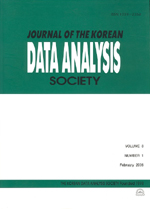선거여론조사에 가중치가 미치는 영향분석
The Effect Analysis of Weight in Survey of Public Opinion Result through ARS
- 한국자료분석학회
- Journal of The Korean Data Analysis Society (JKDAS)
- Vol.17 No.6
-
2015.123057 - 3063 (7 pages)
- 31

오늘날 여론조사는 좋은 표집틀의 부재, 저조한 응답률 등 여러 가지 문제점이 조사과정에 포함되어 있는 것을 인정하면서도 정보 수집을 위하여 수행할 수밖에 없는 도구이다. 그런데 이 조사가 선거예측을 목적으로 하여 사용될 때에는 이러한 문제점이 선거결과에 중대한 위험요소를 제공하게 된다고 볼 수 있다. 특히 오늘날과 같이 세대 간 정치성향의 차이가 크고 또한 세대 간 응답률의 차이가 극단적으로 나타나는 상황에서는 선거여론조사의 예측이 초래하는 왜곡현상은 심각할 수밖에 없다. 이에 중앙선거관리위원회는 2014년 3월에 선거여론조사공정심의위원회를 출범시키고 “선거여론조사기준”을 제시하였다. 그런데 이 기준을 적용하는 과정에서 사후가중치 문제가 주요 이슈가 되었으나 가중치에 대한 제약을 정할만한 근거 확보에서 어려움이 있었다. 이에 본 논문에서는 가중치가 미치는 영향에 대한 기초연구를 수행하는데 특별히 여러 가지 상황에서 모의실험들을 통하여 산출된 예비연구 결과들을 포괄적으로 통합하기 위하여 확률모형을 적용하여 근사적인 영향력 정도를 산출하였다. 또한 선거여론조사 결과를 발표할 때 고려할 사항들로 일반적인 무응답률 뿐만 아니라 무응답이 발생한 층의 전체 표본크기에 대한 표본크기 비율과 해당 층의 무응답자들의 성향인 무응답자 편향 등을 제시하고 이들의 영향의 정도를 무응답이 없이 기본 가중치가 적용되었을 상황에서 얻게 되는 지지율과 무응답 발생 상황에서 예상되는 지지율을 비교한 결과를 제시하였다.
Recently, the problems of the weight size of sampled data have been raised in the election survey because there exists seriously big difference between the young generation and the old generation with respect to political propensity and also there exists big difference between the two generations with respect to the response rate. Such non-responses or excessive responses in the survey cause very large or small size of weights, which may induce seriously biased results. Such undesirable situation of distorted prediction asks the National Election Commission to make a guideline about the allowable weight size. However no practical researches have been done about how much the over/under weights influence the bias of the estimates with weights applied. In this paper we showed the approximate amount of the biases using simple probability models and found that the important influential factors are the non-response rate of the sub-populations whose approval rate is to be estimated, the non-response bias and the proportions of sub-populations of whose non-response rates is the highest and the lowest among the sub-populations.
1. 서론
2. 선행연구
3. 연구내용
4. 결론
References
(0)
(0)